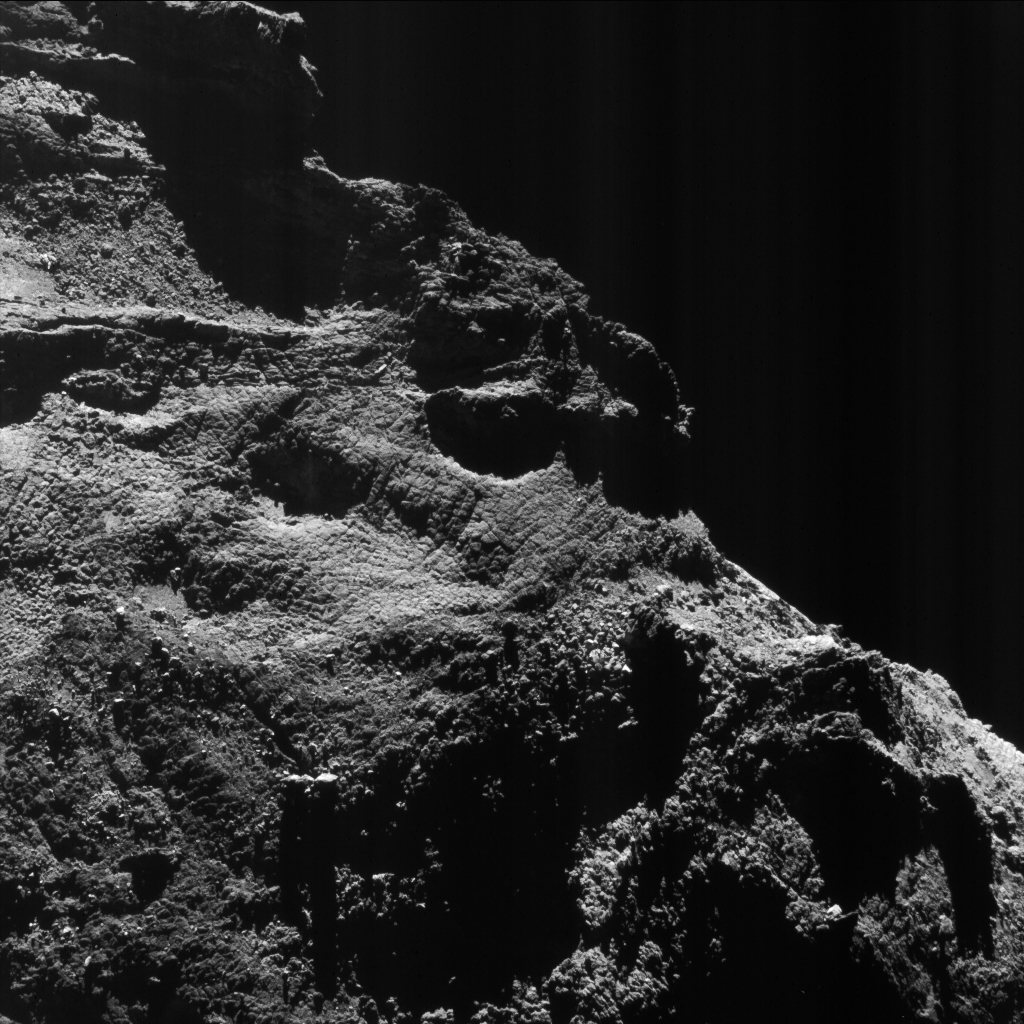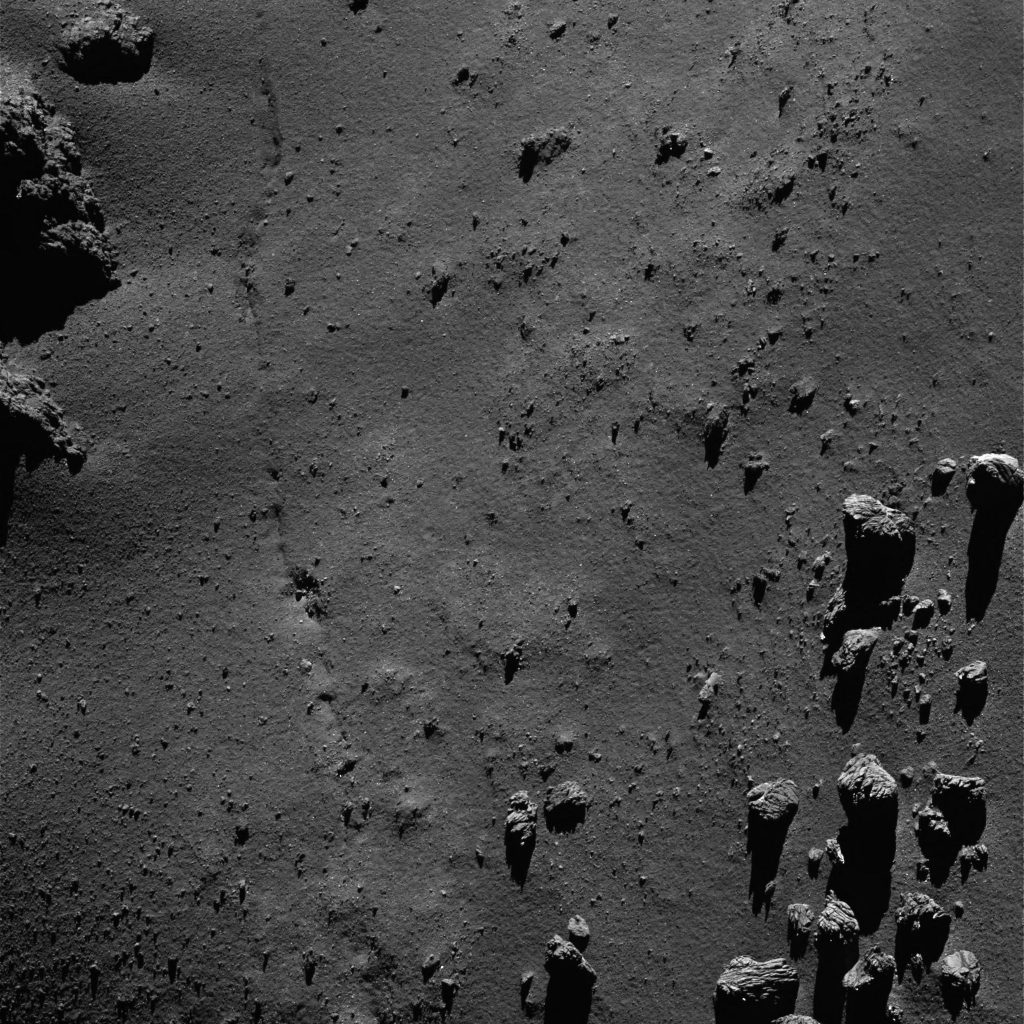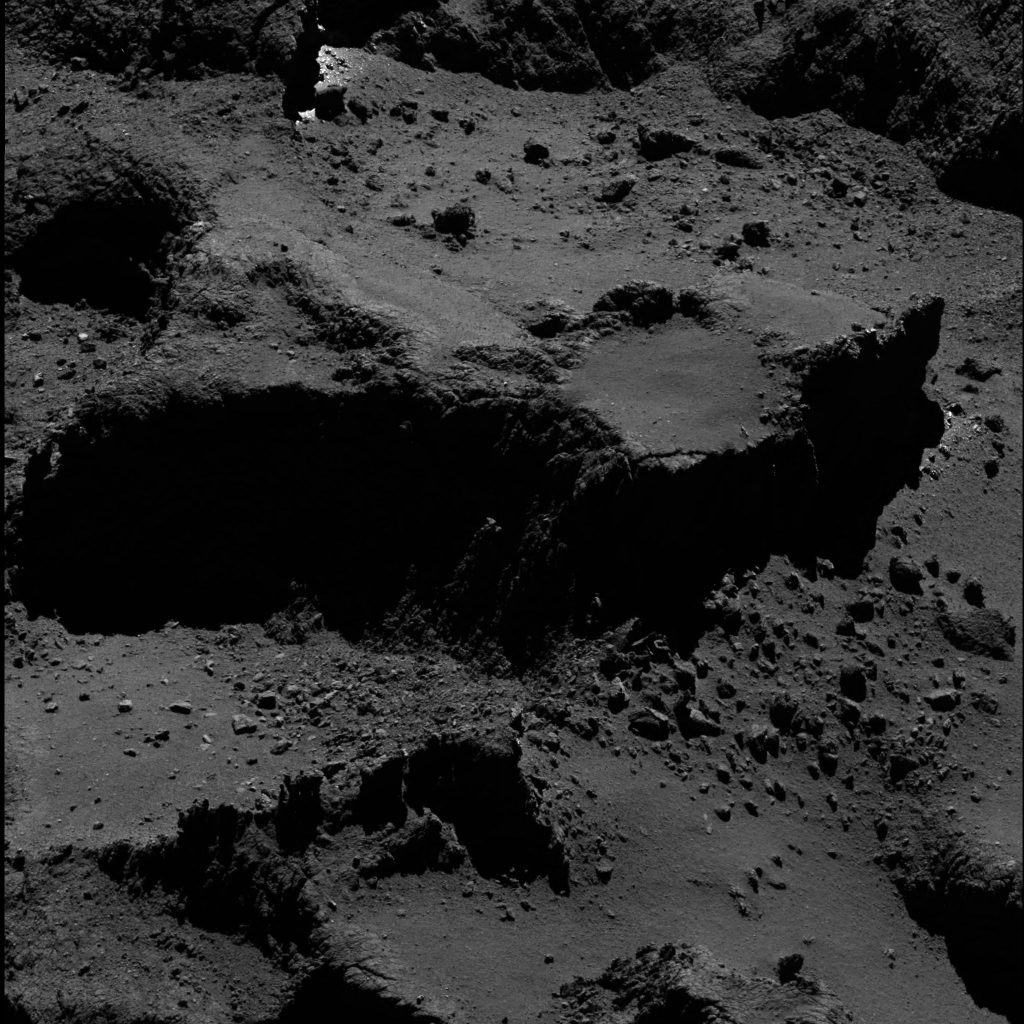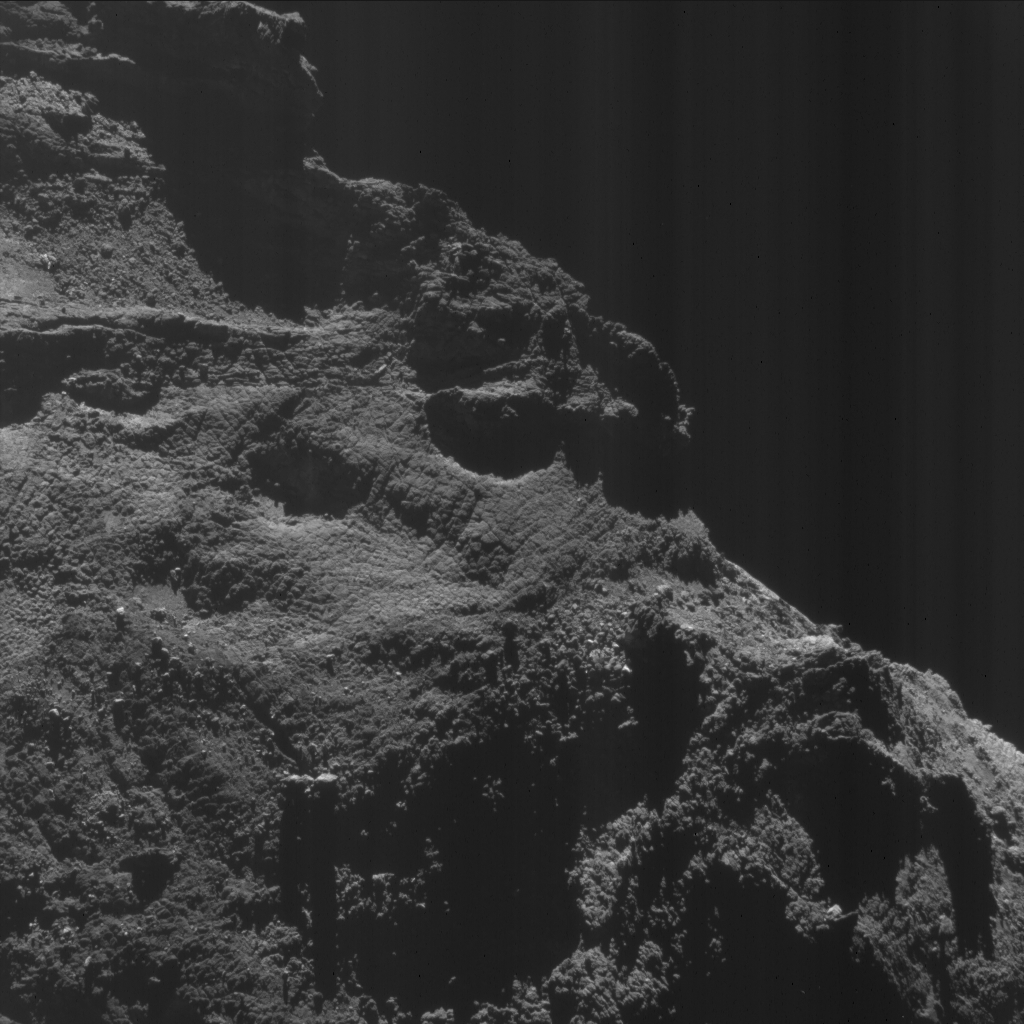This stunning view along the boundary between Hatmehit and Wosret was captured by Rosetta’s NAVCAM on 24 July from a distance of 9.7 km to the centre of Comet 67P/Churyumov-Gerasimenko.

Enhanced NAVCAM view of Comet 67P/Churyumov-Gerasimenko, taken from a distance of 9.7 km on 24 July 2016. The image scale is 0.8 m/pixel and the image measures 0.9 km across. Credits: ESA/Rosetta/NAVCAM – CC BY-SA IGO 3.0
The field of view includes the CONSERT search ellipse that has guided the search for Rosetta’s lander Philae since it landed unexpectedly in the yet-to-be identified location known as Abydos (check this animation for a reminder of the search area).
The image also captures beautiful details of the cross-cutting fracture patterns that prevail in many locations all over the comet; they are particularly prominent towards the left of this scene.
Numerous boulders cling to the surface, and in some places – notably in the lower left quadrant of the image – cast impressively long shadows across the comet’s surface. To the right and above, long shadows are also cast by local variations in topography.

OSIRIS narrow-angle camera image taken on 20 July 2016, when Rosetta was 9.1 km from the centre of Comet 67P/Churyumov–Gerasimenko. The scale is 0.16 m/pixel at the comet and the image measures about 330 m. Credits: ESA/Rosetta/MPS for OSIRIS Team MPS/UPD/LAM/IAA/SSO/INTA/UPM/DASP/IDA
Meanwhile a close-up view of part of the ‘neck’ region of the comet, Hapi, was released via the OSIRIS Image of the Day site earlier this week (above). It shows hints of the crack snaking through the Hapi region, with some portions apparently infilled by dust.
This image also shows incredible details on the boulders and outcropping material that pockmark the smooth, dust-laden neck, with fractures permeating even at these smaller scales.

OSIRIS wide-angle camera image taken on 23 July 2016, when Rosetta was 9.6 km from the centre of Comet 67P/Churyumov–Gerasimenko. The scale is 0.16 m/pixel at the comet and the image measures about 330 m. Credits: ESA/Rosetta/MPS for OSIRIS Team MPS/UPD/LAM/IAA/SSO/INTA/UPM/DASP/IDA
Fractures of a different kind are seen in the OSIRIS narrow-angle camera image taken 23 July and released yesterday (above), notably the fracture along the cliff edge close to the centre of the image. Fractures like these have been spotted along the edges of numerous cliffs in this region – Seth – and are likely a precursor to collapse, as suggested by the jumbled debris that is typically seen at the base of cliffs.
The original 1024 x 1024 pixel image for today’s NAVCAM image is provided below:










Discussion: 18 comments
Hi Emily
Regarding the third image (of Seth), I’ve identified the probable reason for the crack you mention along the cliff edge, close to the centre of the image. I’ve done a post to show it, along with other observations. These observations explain pretty well every cliff, ridge and boulder field in this image by invoking just two predicted tensile vectors brought about by spin-up of the comet. This is in keeping with my comment made on yesterday’s post, “How Comets Are Born”, in which I said that stretch theory can now explain the morphology of every named region of the comet and that those explanations are internally consistent, as dictated by the constraints of the tensile force vectors of stretch.
https://scute1133site.wordpress.com/2016/07/29/part-50-the-blocky-rectangle-slide-at-seth/
And the race begins for amateurs to prove what happened to Philae!
Yes that’s a pretty nice photo to look after philae 🙂
there’s a bright spot on the bottom right of the photo with unexpected sharp edges (but not exactly inside the Consert ellipse).
Shouldn’t philae look brighter with high exposure?
I have studied many images, both pre and post perihelion in and around Abydos. There is one definite change I have found:
https://marcoparigi.blogspot.com.au/2016/08/67p-comet-changes-near-abydos.html
in which two large boulders visible in all suitable pre-perihelion images, have disappeared in all suitable post-perihelion images. The reason, A Cooper and I have found, is that a part of the cliff face has collapsed into Hatmehit and in the process the two nearby boulders have followed.
Of course it would be nice to find the corresponding rubble pile in Hatmehit, but these images have tantalising hints of glints from Philae as well. Not quite enough to prove location, but I am quite satisfied that the surrounding terrain matches the images from Philae’s cameras.
Dear Emily, thanks for getting us a shot of where Philae likely is, but is it possible to give us an Osiris Cam image of the same area of recent?
Thanks so much!
Hi Ramcomet,
There are several suitable NAVCAM images of the area if one is willing and able to look. By the time the OSIRIS ones are published we will know what the surrounds looks like. Those close ups are hard to place!
What about the light spot with sharp edges at the bottom right of the photo? Philae should look brighter with camera high exposure.
Hi jchbarre,
The glint from Philae would only be about a single pixel at highest resolution. You would have to know where to look for context with other studies and look at that exact pixel that is bright where pre-landing images show it to be dull or black.
It wouldn’t be fun if I told people exactly where to look 😉
…
You really think it will still ‘glint’?
By now it’s pretty certainly covered in dust, or worse.
There may be very little contrast, only geometry to look for – if we are lucky.
Hi Harvey,
Yes. It is still glinting. However, it has dropped further into the crevice that it is in and thus even more often shadowed and still hard to find.
“Dust fall” is an imaginary trans perihelion phenomenon. No self respecting dust particle will want to fight the vacuum sucking it away from the nucleus, as well as its own capacity to bounce away if it ever randomly struck the surface. All the areas that look like air fall are something else.
It is important to understand the changes at Abydos before we have a realistic chance to connect all the evidence regarding current position….
The vacuum does not ‘suck it away from the nucleus’.
By now, even just above the surface, the pressure is extremely low, and we are in molecular flow, not viscous.
Disuse particles will just follow ballistic trajectories with very little effect from the gas.
How do you *know* ‘it is still glints Ng’? A sub micron layer of dust is all it needs.
Evidence?
Of course, sub micron dust particles cannot be seen in isolation but can when there is viscous flow from jets etc.
Not so much evidence, but I cannot see how a particle can become “airborne” (vacuum borne?) without surging past escape velocity, and if just by chance, it’s trajectory intersects a solar panel or leg of Philae, I don’t see why it would stick.
Not evidence (yet) but logic. I don’t see why Philae would have any less of a glint than Rosetta.
I am keeping to myself where I think the actual glint from Philae is, until the OSIRIS images of the area are published. I am quietly confident that I have seen a glint in more than one of the NAVCAM images….
Guys, the Mac Cam image is .8 meters per PIXEL. You are chasing fairy dust. We need the corresponding superior views of the Osiris Cam images at this range!
Navcam image, not Mac cam image, spellcheck is a pain.
Well I take that back…suppose there would be some surrounding glow on surfaces around Philae that could create a several pixels wide glow. Maybe I see her in Marco’s linked image above.
My guess would be in his top photo: Start from center, move to the left halfway to the left edge, and go up 1/10 of a frame.
Is that Philae’s glow in the “ditch?
The problem isn’t ‘fairy dust’, it’s comet dust…….
Good one Harv! 😉
Top NAVCAM photo optimization is of an insuperable quality. Also, expressive is about the nature of the core material..
https://www.esa.int/spaceinimages/Images/2016/07/Comet_on_24_July_2016_NavCam
That OSIRIS shot with the bright patch at top suggest of very recent icy deposition. The carrier was surface flowing.
https://www.esa.int/spaceinimages/Images/2016/07/Comet_on_23_July_2016_OSIRIS_narrow-angle_camera